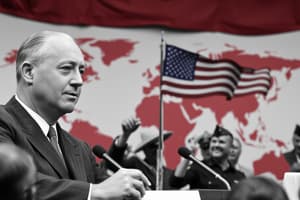Podcast
Questions and Answers
What was the purpose of The Neutrality Acts of 1935-1937?
What was the purpose of The Neutrality Acts of 1935-1937?
The Neutrality Acts were aimed at keeping the United States out of war in Europe.
What was a consequence of FDR's embargo on Japan?
What was a consequence of FDR's embargo on Japan?
- Japan attacked Pearl Harbor (correct)
- Japan formed an alliance with Germany
- Japan withdrew from Europe
- Japan initiated a peace treaty
What effect did the United States' decision not to join the League of Nations have?
What effect did the United States' decision not to join the League of Nations have?
It made the League of Nations weak and ineffectual.
What was the Lend-Lease Act of 1941?
What was the Lend-Lease Act of 1941?
How did military warfare in WWII differ from warfare in WWI?
How did military warfare in WWII differ from warfare in WWI?
How did Hitler violate the Treaty of Versailles?
How did Hitler violate the Treaty of Versailles?
Who was A. Phillip Randolph and how did he change American society?
Who was A. Phillip Randolph and how did he change American society?
Chronologically, identify the order of the following WWII events: Pearl Harbor, Battle of Midway, D-Day, VE-Day, and VJ-Day.
Chronologically, identify the order of the following WWII events: Pearl Harbor, Battle of Midway, D-Day, VE-Day, and VJ-Day.
What was the Battle of the Bulge?
What was the Battle of the Bulge?
What was the government's policy toward women in the workforce during WWII?
What was the government's policy toward women in the workforce during WWII?
What did the Neutrality Act of 1939 expand?
What did the Neutrality Act of 1939 expand?
What was the Lend-Lease Act?
What was the Lend-Lease Act?
Flashcards are hidden until you start studying
Study Notes
The Neutrality Acts (1935-1937)
- Aimed to keep the U.S. out of European conflicts.
- The first two acts prohibited American arms exports to warring nations.
- The Neutrality Act of 1937 banned American travel on ships of nations at war, allowing non-military sales on a "cash and carry" basis.
FDR's Embargo Act
- Imposed a trade embargo on Japan, freezing Japanese assets in the U.S.
- Targeted oil and steel, significantly impacting Japan's military capability.
- This action contributed to Japan's attack on Pearl Harbor.
U.S. Non-Participation in the League of Nations
- The Senate refused to ratify the Treaty of Versailles, leading to U.S. absence in the League.
- U.S. reluctance stemmed from a desire to avoid future conflicts and American casualties.
- The League of Nations became weak and ineffective without U.S. support.
Lend-Lease Act (1941)
- Allowed the U.S. to supply arms to Allies, notably Britain, on a lend-lease basis.
- Aimed to assist nations fighting against Axis Powers without direct military involvement.
Differences in Warfare: WWI vs. WWII
- WWI featured static trench warfare with limited mobility and conventional tactics.
- WWII introduced advanced technologies, including nuclear weapons, missiles, and sophisticated covert operations.
- Germany employed Blitzkrieg tactics for rapid, dynamic assaults.
Hitler's Violations of the Treaty of Versailles (1935-1939)
- Implemented compulsory military service and rebuilt the German military.
- Annexed territories like Austria and parts of Czechoslovakia, escalating tensions in Europe.
A. Philip Randolph's Impact
- Organized the March on Washington, advocating for African American rights in defense industries.
- His activism prompted a presidential order for non-discrimination in war-related employment.
Key WWII Events in Chronological Order
- Pearl Harbor → Battle of Midway → D-Day → VE-Day → VJ-Day
Military Campaigns in Western Europe (June 1944 - May 1945)
- Notable battle: The Battle of the Bulge, which marked the last significant German offensive before Allied victory.
U.S. Government Policy on Women in the Workforce during WWII
- Encouraged women's participation in industry, recognizing their critical role on the Home Front.
- Women worked extended shifts in factories, significantly increasing production levels compared to the male-dominated workforce.
Studying That Suits You
Use AI to generate personalized quizzes and flashcards to suit your learning preferences.




